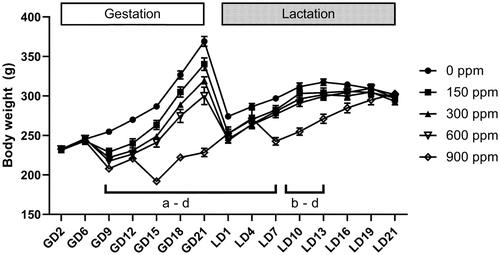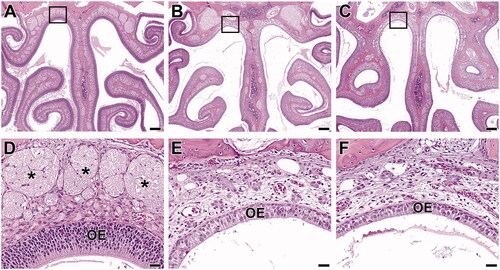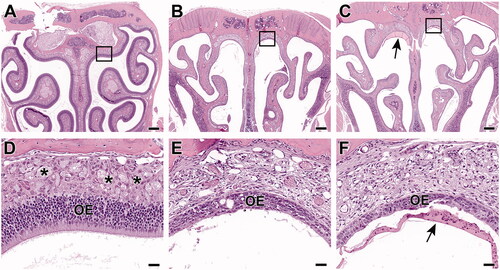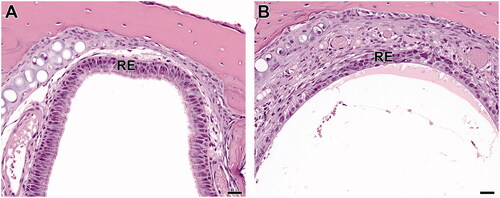Figures & data
Figure 1. Body weight during gestation and lactation of Hsd:Sprague Dawley® SD® dams exposed to 2-ethyltoluene via whole-body inhalation. Dams were exposed to 2-ethyltoluene for 6 h per day, 7 days per week in inhalation chambers from gestation day (GD) 6 to GD 20. No exposure occurred during lactation. Dams in the 1200 ppm group were terminated due to excessive toxicity between GD 8 and GD 10 and data are not shown in the graph. Letters indicate significantly (p < 0.05) lower body weights compared to controls for an exposure group (a: 150 ppm, b: 300 ppm, c: 600 ppm, d: 900 ppm). Data shown as mean ± SEM (n = 11–12 for all groups except 900 ppm with n = 6–8 for 900 ppm). GD: gestation day; LD: lactation day.

Table 1. Reproductive performance, litter data, and pup parameters of Hsd:Sprague Dawley® SD® rats after exposure to 2-ethyltoluene.
Figure 2. Body weight of male and female Hsd:Sprague Dawley® SD® rats exposed to 2-ethyltoluene prenatally and for 2 weeks via whole-body inhalation. Male (A) and female (B) F1 offspring were exposed to 2-ethyltoluene for 6 h per day, 7 days per week in inhalation chambers at the same concentrations as their respective dams for 2 weeks after weaning on postnatal day 21. Animals in the 600, 900, and 1200 ppm exposure groups were terminated early due to excessive toxicity within the first few days of exposure and data are not shown. Letters indicate significantly (p < 0.05) lower body weights compared to controls for an exposure group (a: 150 ppm, b: 300 ppm). Data shown as mean ± SEM (n = 14 for control, n = 8 for exposed).

Figure 3. Body weight of male and female B6C3F1/N mice exposed to 2-ethyltoluene via whole-body inhalation for 2 weeks. Male (A) and female (B) mice at 6 weeks of age were exposed to 2-ethyltoluene for 6 h per day, 7 days per week in inhalation chambers for 2 weeks. The 600, 900, and 1200 ppm exposure groups were terminated early due to excessive toxicity within the first few days of exposure and data are not shown. Letters indicate significantly (p < 0.05) lower body weights compared to controls for an exposure group (a: 150 ppm, b: 300 ppm). Data shown as mean ± SEM (n = 11 for control, n = 8 for exposed).

Table 2. Incidences and average severities for histopathological nasal lesions in male and female Hsd:Sprague Dawley® SD® rats and B6C3F1/N mice after 2-week whole-body inhalation exposure to 2-ethyltoluene.
Figure 4. Level III sections of the nose from Hsd:Sprague Dawley® SD® rats exposed to 2-ethyltoluene prenatally and for 2 weeks via whole-body inhalation. In the control female rat (A, D), a uniformly thick olfactory epithelium (OE) lines all surfaces. In a higher magnification section at the dorsal meatus (area within the box), the olfactory nerves (*) are prominent in the lamina propria underlying the OE. In female rats from 150 ppm (B, E) and 300 ppm (C, F), there is mild atrophy of the both the olfactory epithelium and of the underlying olfactory nerves. (A, B, C: 4× original magnification, scale bar = 250 µm. D, E, F: 40× original magnification, scale bar = 25 µm). H&E.

Figure 5. Level III sections of the nose from B6C3F1/N mice exposed to 2-ethyltoluene via whole-body inhalation for 2 weeks. In the control female mouse (A, D), a uniformly thick olfactory epithelium (OE) lines all surfaces. In a higher magnification section at the dorsal meatus (area within the box), the olfactory nerves (*) are prominent in the lamina propria underlying the OE. In female mice from 150 ppm (B, E) and 300 ppm (C, F), there is marked atrophy of the both the olfactory epithelium (OE) and of the olfactory nerves (*). The olfactory nerves are readily observable in the control animal (see asterisks in D), but they are inapparent in the animals from 150 ppm (E) and 300 ppm (F). There is also inflammatory exudate present (arrow). (A, B, C: 4× original magnification, scale bar = 250 µm. D, E, F: 40× original magnification, scale bar = 25 µm). H&E.

Figure 6. Level I sections of the nose from B6C3F1/N mice exposed to 2-ethyltoluene for 2 weeks via whole-body inhalation. In the control female mouse (A), the dorsal meatus of Level I is lined with respiratory epithelium (RE). In a female mouse exposed to 150 ppm 2-ethyltoluene (B), the respiratory epithelium atrophy is seen as attenuation and thinning of the respiratory epithelium (RE) in a Level I section of the nose. 40× original magnification, scale bar = 25 µm. H&E.

Table 3. Concentrations (ng/mL) of 2-ethyltolutene in blood from Hsd:Sprague Dawley® SD® rats and B6C3F1N mice after 2-week whole-body inhalation exposure to 2-ethyltoluene.
